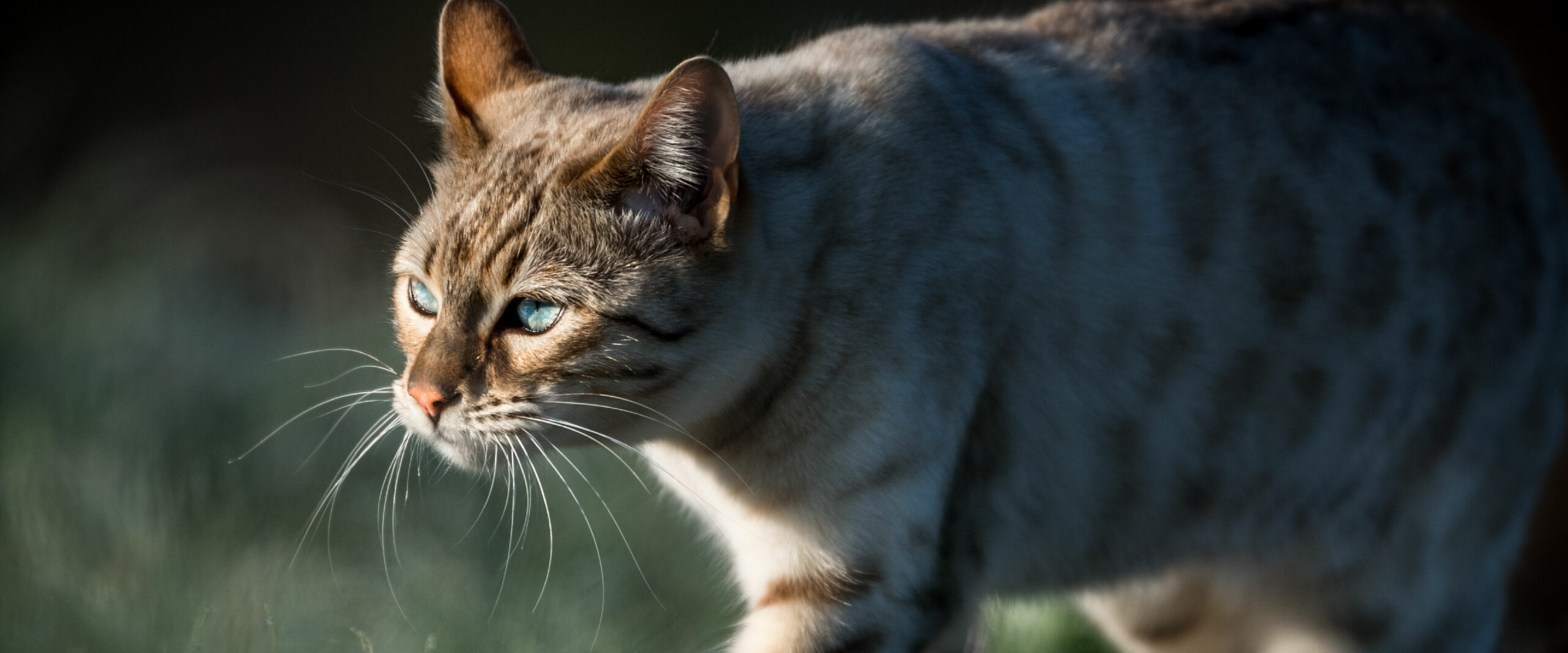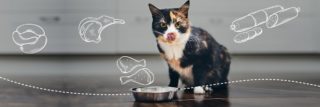
Chronic kidney disease (CKD) is a common disease in cats and affects around 30 % to 40 % of cats over 10 years of age. Initially, the disease usually progresses gradually with mild symptoms. As the disease progresses, severe clinical symptoms can occur, which are associated with uremia. UraemiaA raised level in the blood of urea and other urinary substances, which in chronic kidney disease can no longer be adequately excreted due to impaired renal function (glomerular filtration rate). This leads to renal damage due to uraemic toxins, toxic urinary substances The symptoms... refers to blood poisoning with urinary substances and occurs when the kidneys are unable to filter these urinary waste products properly and excrete them via the urine. Clinical symptoms of uraemia can include mouth ulcers, vomiting, loss of appetite and lethargy. These affect the quality of life of affected CKD cats. A number of treatment techniques to slow and prevent the development of uraemia are currently being investigated and should be considered in cats with CKD.
Gut-kidney axis as a driver of uraemia
More and more research results in numerous studies support the concept of the gut-kidney axis, a significant connection between the two organs that has considerable reciprocal effects on the health of the other organ. In the context of CKD, uraemia has been shown to negatively affect the gut microbiota by causing an imbalance of bacteria, also known as dysbiosisImbalance of organisms of the the microbiome (all microbes on or within an animal’s tissues), for instance the imbalance of the intestinal flora as part of the microbiome..... The diversity of bacteria decreases and certain (undesirable) types of bacteria overgrow. The latter bacteria in particular lead to uraemia being supported because they convert essential amino acids into precursors of uraemic toxinsToxic, nitrogen-containing urinary substances responsible for uraemia and kidney damage.... (such as indole and p-cresol), so that more uraemic toxins are produced during dysbiosis. This sets a vicious circle in motion.
Uraemic toxins from the intestinal microbiota
Of particular interest are those uraemic toxins that are waste products of protein metabolism (e.g. Indoxyl sulfate, p-cresyl sulfate), as it is assumed that these not only have negative effects on the intestinal microbiota (the above-mentioned dysbiosis), but also contribute to clinical symptoms of uraemia. Uraemic toxins such as Indoxyl sulfate and p-cresyl sulfate are produced in the colon by the microbial breakdown of the essential amino acids tryptophan (Indoxyl sulfate) or tyrosine and phenylalanine (p-cresyl sulfate). Microbial digestion first produces the precursors indole and p-cresol in the intestine, which are then absorbed into the blood and only converted into the actual uraemic toxins indoxyl sulfate and p-cresyl sulfate by enzymes in the liver.
Harmful effects of uraemic toxins
Uraemic toxins, which accumulate in the blood of patients with chronic kidney disease due to decreased renal output, are known to have deleterious effects. The accumulation of indoxyl sulfate and p-cresyl sulfate in CKD is associated with:
- Increased production of free radicals leading to tissue damage;
- Activation of the renin-angiotensin-aldosterone system, which promotes hypertensionHigh blood pressure. in CKD;
- by promoting renal fibrosis, triggering inflammation, damaging renal tubular cells (in the tubular system of the nephronsNephrone sind die Filtereinheiten der Nieren....) and stimulating glomerular sclerosisThe hardening of an organ or tissue caused by a replacement of normal tissue with connective tissue. Sclerotic tissues and organs are less elastic.... (= glomerulosclerosis = irreversible scarring of the filtering units of the nephrons, leading to the loss of the filtering units);
all of which contribute to the progression of CKD and increased mortality in CKD cats.
These uraemic toxins also impair the neurological system, blood formation (by inhibiting the production of erythropoietinErythropoietin, abbreviated to EPO, is a growth factor that stimulates red blood cell production. EPO can be produced biotechnologically and administered for kidney failure or after chemotherapy...., a hormone produced in healthy kidneys) and bone turnover. Indoxyl sulfate and p-cresyl sulfate accelerate muscle atrophyWasting away of tissue, a reduction in the volume and/or size of tissues or organs.... and increase the risk of cardiovascular disease.
Indoxyl sulfate and CKD in cats
In cats with CKD, bacterial diversity and abundance is decreased due to the prevalent dysbiosis supported by uraemic toxins such as Indoxyl sulfate. In addition, Indoxyl sulfate is elevated in cats with CKD and is directly associated with disease progression. In a study with CKD cats in IRIS stage 2, an early stage of CKD, significantly higher Indoxyl sulfate concentrations were already detected in the blood compared to healthy cats. The results of this study suggest that therapeutic measures to reduce uraemic toxins such as Indoxyl sulfate are recommended in the treatment of CKD cats.

Reduction of uraemic toxins
There are different approaches to reducing uraemic toxins in CKD cats.
Protein reduction in renal diets
On the one hand, reducing protein intake can reduce the formation of uraemic toxins and thus clinical signs of uraemia. This is the central idea behind the historical recommendation to limit protein in veterinary renal diets. However, there is no consistent data on the effects of different protein levels on uraemic toxins in cats. In one study in healthy cats, a higher protein diet was associated with transiently increased concentrations of p-cresyl sulfate, but not Indoxyl sulfate. On the other hand, in another study of cats with early-stage CKD, increased blood concentrations of uraemic toxins were associated with higher dietary protein levels. Currently, recommendations for protein content in CKD cats are more concerned with balancing the treatment goal of protein reduction with maintenance of body mass. (Note: The cat, as an obligate carnivore, is dependent on a high protein diet to prevent muscle wasting and weight loss). Ensuring adequate calorie intake when feeding a protein-reduced diet is key to ensuring that the cat receives sufficient dietary protein.
Reducing the absorption of uraemic toxins
Reducing the absorption of uraemic toxins is another treatment strategy that can be used to reduce uraemia. Porus® One (ingredient: Renaltec®), a high performance carbon-based adsorber, is designed to bind precursors of Indoxyl sulfate and p-cresyl sulfate in the intestine to aid in fecal excretion. Porus® One is odorless and tasteless and can be mixed into the food and easily administered to cats at mealtimes. A recent study from 2024 at the LMU in Munich concludes that the additional use* of Porus® One significantly reduces Indoxyl sulfate and could also lead to an improvement in the progression of IRIS stage 2 and 3 cats.
There is also the possibility of using special probiotics/prebiotics that target the microbiomeAll microbes on or within an animal’s tissues, for instance in the intestines (intenstinal flora = the totality of all microorganisms that colonise the intestine). It includes bacteria, protozoa, fungi and viruses.... and are intended to lead to less uraemic toxins being produced by the intestinal bacteria. Data on the effectiveness of these products in reducing Indoxyl sulfate concentrations in cats with chronic kidney disease are not yet available.
Increase bowel activity
(see blog post: Constipation – gut-wrenching bowel activity)
Constipation and slow bowel movements are more common in cats with CKD and may be related to electrolyte imbalances and dehydrationA deficit of total body water. Dehydration can be caused by excessive fluid loss, for instance via the kidneys in CKD, or by insufficient fluid intake..... In addition, uraemic toxins may also have a negative effect on intestinal function and, conversely, constipation may lead to higher levels of uraemic toxins. This has been demonstrated in patients with chronic kidney disease compared to those with normal digestion. Increasing bowel activity may also help to reduce uraemic toxins produced by increased protein breakdown during bowel inactivity (note: intestinal bacteria then come into contact with more protein, allowing more to be broken down). Therapeutic approaches to improve bowel function and reduce constipation may include correcting dehydration and electrolyte imbalances with fluids and the use of stool softeners. However, stool softeners have the disadvantage of drawing water into the intestine and binding it there so that it is lost in the stool. This promotes dehydration in the CKD cat and can be counterproductive.
Summary:
- Uraemia is the accumulation of waste products (such as uraemic toxins) in the blood due to decreased kidney function. It can lead to clinical symptoms such as vomiting, loss of appetite, mouth ulcers and lethargy in patients with chronic kidney disease.
- Uraemic toxins contribute to worsening renal function and progression of CKD and have wide-ranging systemic effects, such as accelerated muscle wasting and decreased production of erythropoietin, which can lead to anaemia.
- Targeted reduction of uraemic toxins can be an effective treatment to improve the clinical picture of patients with chronic kidney disease, thereby improving their quality of life and slowing the progression of CKD.
- Porus® One, a tasteless and odorless adsorber for cats with chronic kidney disease, binds the precursors of uraemic toxins in the intestine. These are then excreted in the feces before they can be converted into uraemic toxins.
Bibliography
- Elzenbeck, I., Teichmann-Knorrn, S., Hartmann, K., Zablotski, Y., Suchodolski, J., & Dorsch, R. (2024). Evaluierung des Effekts von Renaltec bei Katzen mit chronischer Nierenerkrankung im IRIS-Stage 2 und 3. [Poster Presentation]. 31. Jahrestagung der DVG-Fachgruppe “Innere Medizin und klinische Labordiagnostik.”. 03.-04. February 2024, Göttingen.
- Quimby, J. (2023). Uremic Toxins in Feline Chronic Kidney Disease: Why Should We Care? Clinician’s Brief. https://www.cliniciansbrief.com/article/clinical-notes-uremic-toxins-feline-chronic-kidney-disease-why-should-we-care
- Quimby, J. (2023, 17. June). Uremic Toxins a Targeted Therapy. [Conference Paper]. ACVIM Forum. Philadelphia, Pennsylvania, USA. 09:10-10:10 am.
*All cats in both the control and Renaltec® groups were treated according to IRIS guidelines and received both renal diet and medication. The Renaltec®-treated group received 500 mg Renaltec® once daily in addition to the renal diet and medication.


